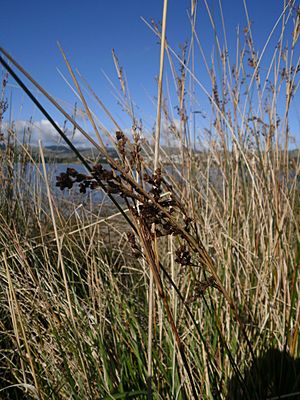Salt marsh rush facts for kids
Quick facts for kids Salt marsh rush |
|
|---|---|
 |
|
| Juncus kraussii subsp. australiensis | |
| Scientific classification | |
| Genus: |
Juncus
|
| Species: |
kraussii
|
| Subspecies | |
|
Juncus kraussii subsp. austerus (Buchenau) Snogerup |
|
Juncus kraussii is a special plant known by many names. People call it the salt marsh rush, sea rush, or matting rush. It belongs to the rush family, Juncaceae. This plant loves to grow in salty places. You can find it in salt marshes, river mouths (estuaries), and along coastlines.
It's super helpful for keeping riverbanks strong. This rush stops the soil from washing away, which is called erosion. It also provides a great natural material for weaving.
The plant gets its name from a German scientist, Christian Krauss. He was a naturalist and museum worker. Christian Krauss traveled to South Africa to study nature.
What Does the Salt Marsh Rush Look Like?
This plant grows in a special shape called a tussock. A tussock is like a clump or a bunch of grass. It is a perennial plant, meaning it lives for many years. It has many underground stems called rhizomes.
The leaves of the salt marsh rush are tough. They look like straw and have a pointy tip. They can grow quite long, from 40 centimetres (16 in) to 150 centimetres (59 in). The bottom part of the leaves has a golden brown or shiny black cover.
The flowers of J. kraussii are called inflorescences. They are reddish-brown to purplish-brown. These flower clusters are 4 centimetres (1.6 in) to 20 centimetres (7.9 in) long. You'll find them grouped near the end of the stem. The flowers usually grow in small bunches of three to six. They bloom in the summer, from October to January.
Where Does the Salt Marsh Rush Grow?
You can find Juncus kraussii in many different places around the world. It grows in all states of Australia and in New Zealand. It is also found in Southern Africa and South America.
This rush can handle salty water very well. It prefers places that are damp. You will often see it in swamps and in estuaries where the water is a bit salty (brackish). The plant is not picky about soil. It can grow in sandy areas or in rich river mud called alluvium.
How Do People Use the Salt Marsh Rush?
In many Zulu areas of South Africa, people use Juncus kraussii a lot. They harvest the plant and weave its fibers. They make traditional sleeping mats, baskets, and strainers for beer. They also create other beautiful crafts.
This plant is very popular because it helps people earn money. Because of its value, it was collected a lot from the wild. Now, people grow it on farms. They harvest it every year for about seven years from the same plant.
Long ago, Indigenous Australians also used the stems and leaves of Juncus kraussii. They made strong fibers from it. These fibers were used to make string, fishing lines, woven rugs, and baskets.
Today, the salt marsh rush is still very useful. It helps keep the banks of estuaries strong. It also stabilizes areas around salt marshes and riverbanks near towns. This plant is also used in special water cleaning systems called biofiltration systems and in rain gardens.

